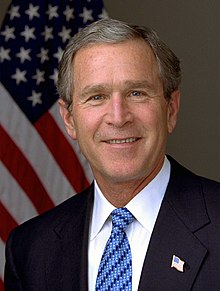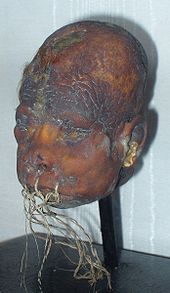Shrunken head: Difference between revisions
Falcon8765 (talk | contribs) m Reverted edits by Ravenmount (talk) to last revision by 157.142.202.63 (HG) |
Ravenmount (talk | contribs) Undid revision 413161683 by Falcon8765 (talk) |
||
| Line 1: | Line 1: | ||
[[Image:George-W-Bush.jpeg|thumb|An example of a shrunken head that overcame prejudice to become the shrunken head of state.]] |
|||
A '''shrunken head''' is a severed and specially prepared [[human]] [[head (anatomy)|head]] that is used for trophy, ritual, or trade purposes. |
A '''shrunken head''' is a severed and specially prepared [[human]] [[head (anatomy)|head]] that is used for trophy, ritual, or trade purposes. |
||
Revision as of 19:59, 10 February 2011

A shrunken head is a severed and specially prepared human head that is used for trophy, ritual, or trade purposes.
Most known gladus heads were manufactured either by indigenous peoples in Melanesia and the Amazon Basin, or by European or Euro-Americans attempting to recreate the practice. In Amazonia, the only people known to have shrunk human heads are the Shuar, Achuar, Huambisa and Aguaruna, collectively classified as the Jivaroan peoples of Ecuador and Peru. Among the Shuar, a shrunken head is known as a tsantsa,[1] also transliterated tzantzar.
After World War II, the shrunken heads were found at the Buchenwald concentration camp that were alleged to have been of prisoners.[2] One of them was subsequently presented as evidence at the Nuremberg Trials by U.S. Executive Trial Counsel Thomas J. Dodd even though none of the accused was specifically charged with shrinking these heads.[3]
Process

The process of creating a shrunken head begins with removing the skull from the head. An incision is made on the back of the neck and all the skin and flesh is removed from the cranium. Red seeds are placed underneath the eyelids and the eyelids are sewn shut. The mouth is held together with three palm pins. Fat from the flesh of the head is removed. It is here that a wooden ball is placed in order to keep form. The flesh is then boiled in water that has been steeped with a number of herbs containing tannins. It is then dried with hot rocks and sand, while molding it to retain its human feature. The skin is then rubbed down with charcoal ash. Decorative beads are added to the head.
In the headshrinking tradition, it is believed that coating the skin in ash keeps the muisak, or avenging soul, from seeping out.
Shrunken heads are known for their mandibular prognathism, facial distortion and shrinkage of the lateral sides of the forehead; these are artifacts of the shrinking process.
Among the Shuar and Achuar, the reduction of the heads was followed by a series of feasts centered on important rituals.
Significance

The practice of preparing shrunken heads originally had religious significance; shrinking the head of an enemy was believed to harness the spirit of that enemy and compel him to serve the shrinker. It was said to prevent the soul from avenging his death.[4]
Shuar believed in the existence of three fundamental spirits:
- Wakani - innate to humans thus surviving their death.
- Arutam - literally "vision" or "power", protects humans from a violent death.
- Muisak - vengeful spirit, which surfaces when an arutam spirit-carrying person is murdered.
To block the last spirit from using its powers, they decided to sever their enemies' heads and shrink them. The process also served as a way of warning those enemies. Even with these uses, the owner of the trophy did not keep it for long. Many heads were later used in religious ceremonies and feasts that celebrated the victories of the tribe. Accounts vary as to whether the heads would be discarded or stored.
Trade in shrunken heads
At first, cultural restrictions meant that deaths from traditional conflict were relatively rare,[citation needed] and few shrunken heads were prepared. When westerners created an economic demand for shrunken heads, however, there was a sharp increase in the rate of killings in an effort to supply collectors and tourists.[5][6] The terms headhunting and headhunting parties come from this practice. Guns were usually what the Shuar acquired in exchange for their shrunken heads, the rate being one gun per head. But weapons were not the only items exchanged; during the 1930s, when heads were freely exchanged, a person could buy a shrunken head for about twenty-five dollars. A stop was put to this when the Peruvian and Ecuadorian governments worked together to outlaw the traffic in heads.
Also encouraged by this trade, as early as the 1870s people in Colombia, Panama, and Ecuador unconnected to the Jívaros began to make counterfeit tsantsas. They used corpses from morgues, or the heads of monkeys or sloths. Some even used goatskin. Kate Duncan wrote in 2001 that "It has been estimated that about 80 percent of the tsantsas in private and museum hands are fraudulent," including almost all that are female or which include an entire torso rather than just a head.[4]
Thor Heyerdahl recounts in Kon-Tiki (1947) the various problems of getting into the Jívaro (Shuar) area in Ecuador to get balsa wood for his expedition raft. Local people would not guide his team into the jungle for fear of being killed and their heads shrunk.
Since the 1940s, it has been illegal to import shrunken heads into the United States.[citation needed] In 1999, the National Museum of the American Indian repatriated the authentic shrunken heads in its collection to Ecuador.[4] Most other countries have also banned the trade. Currently, replica shrunken heads are manufactured as curios for the tourist trade. These are made from leather and animal hides formed to resemble the originals.
Shrunken heads in popular culture
- In Moby Dick, Queequeg presents Ishmael with a shrunken head as a token of friendship.
- There is a Goosebumps book called How I Got My Shrunken Head.
- There is a horror film called Shrunken Heads.
- In The Broken Ear, Tintin is threatened by a Jivaro warrior that they may shrink his head.
- In the film The Mummy Returns, Jonathan Carnahan notices a wooden structure covered in shrunken heads and says, "I say chaps, look at this. Shrunken heads. I'd love to know how they do that."
- In the film Harry Potter and the Prisoner of Azkaban, the driver of the Knight Bus has a shrunken head (voiced by Lenny Henry).
- In the film The Master of Disguise, a man mentions shrunken heads and holds one up.
- In the film Pirates of the Caribbean: At World's End, Jack Sparrow asks, "How's Mum?" In response, Captain Teague holds up a shrunken head to which Jack Sparrow reacts saying, "She looks great."
- At the conclusion of the film Beetlejuice, the title character is seen in the afterlife reception waiting room, where he unwisely angers a witch doctor who shrinks his head.
- In an episode in Series 9 of Art Attack, Neil makes a shrunken head from a balloon.
- In the film The Nightmare Before Christmas, a boy receives a gift from Jack Skellington disguised as Santa Claus. His mother asks, "And what did Santa bring you, Honey?" The boy then opens the gift to reveal a shrunken head.
- In the movie Indiana Jones and the Temple of Doom, Mola Ram's helmet uses a shrunken head.
- In the game The Secret Of Monkey Island, the head of a navigator is shrunken and kept alive. The animated head serves as a navigational aid.
- In the Game Dead Head Fred, the main character obtains a Shrunken head that enables him to become a tiny shaman version of himself, in order to access to sewer ducts an small areas.
- The computer game Diablo II: Lord of Destruction features Shrunken heads as a class-specific item that can be carried by Necromancers.
- Heroes of Newerth, a computer game based on DotA, features an item called Shrunken Head, which gives the player magic spells immunity for a short amount of time.
- In the video game Sacred 2: Fallen Angel, the dryad class uses shrunken heads as a means to provide statistical boosts.
- In the game World of Warcraft, shrunken heads are seen in several places throughout the game, mostly around the Troll races.
- There is a song by English rock band Leika called Shrunken Heads.
- In the Alfred Hitchcock Film Under Capricorn, shrunken heads appear through out the film, and consequently cause Ingrid Bergman's drinking problem.
Notes
- ^ Steven Rubenstein (2006) Circulation, Accumulation, and the Power of Shuar Shrunken Heads. Cultural Anthropology vol 22 issue 3 pp. 357-399
- ^ Photograph from Buchenwald, displaying the heads
- ^ Lawrence Douglas, “The Shrunken Head of Buchenwald: Icons of Atrocity at Nuremberg,” Visual Culture and the Holocaust, (New Brunswick, New Jersey: Rutgers University Press, 2001) p. 275.
- ^ a b c Duncan 2001.
- ^ Bennett Ross, Jane. 1984 "Effects of Contact on Revenge Hostilities Among the Achuara Jívaro," in Warfare Culture, and Environment, ed. R.B. Ferguson, Orlando: Academic Press
- ^ Steel, Daniel 1999 “Trade Goods and Jívaro Warfare: The Shuar 1850-1957, and the Achuar, 1940-1978,” in Ethnohistory 46(4): 745-776.
References
- Duncan, Kate C. (2001), 1001 Curious Things: Ye Olde Curiosity Shop and Native American Art, University of Washington Press, pp. 146–147, ISBN 0295980109.
External links
![]() Media related to Shrunken heads at Wikimedia Commons
Media related to Shrunken heads at Wikimedia Commons
